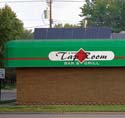FM Global recommends performing field uplift testing as a quality-assurance measure on most membrane roof systems in hurricane-prone regions of the U.S. NRCA has concerns about whether FM Global's test method provides an accurate prediction of quality installation and actual uplift performance.
For buildings located in hurricane-prone regions where the design wind speed is 100 mph or greater, FM Global recommends to its insurers that acceptance of and final payment for most new membrane roof systems be based on satisfactory completion of a field uplift test. In the U.S., this recommendation applies along the Atlantic and Gulf coasts and in American Samoa, Guam, Hawaii, Puerto Rico and the U.S. Virgin Islands.
The FM test
FM Global recommends such testing be conducted according to Loss Prevention Data Sheet 1-52 (FM 1-52), "Field Uplift Tests." FM 1-52 provides two methods of testing membrane roof systems: bonded uplift and negative pressure.
With the negative-pressure test method, which is sometimes referred to as the "bubble test," a 5- by 5-foot chamber is placed over a roof surface and a negative pressure is created inside the chamber. The roof surface's upward deflection is measured, and failure occurs if the deflection reaches a certain limit.
The FM 1-52 negative-pressure test is based, in part, on consensus-developed ASTM E907, "Standard Test Method for Field Uplift Resistance of Adhered Membrane Roofing Systems." However, FM 1-52 differs from ASTM E907 in several areas.
FM 1-52 recommends locating a test chamber between supporting beams or joists, which results in adding the effect of deck deflection to the test results. ASTM E907 does not make a similar recommendation regarding test chamber placement, but it indicates a roof surface's stiffness may be influenced by a deck's stiffness and connections between the deck and framing.
Using FM 1-52, the maximum allowable roof surface deflection for adhered membrane systems is 1/4 of an inch for a test pressure of 60 pounds per square foot (psf) or less, 1/2 of an inch for 60 to 120 psf, 3/4 of an inch for 120 to 180 psf and 15/16 of an inch for 180 to 225 psf. ASTM E907 provides for a 1-inch allowable roof surface deflection.
Successfully passing the FM 1-52 test is based on withstanding a test pressure of 1.5 times the design wind-uplift pressure. In ASTM E907, testing is conducted up to an agreed upon pressure, which typically is the design uplift pressure (without the 1.5 factor).
The differences between FM 1-52 and ASTM E907 make FM 1-52 considerably more restrictive than ASTM E907.
Failing a test
When a roof system fails an FM 1-52 (or ASTM E907) test, most roofing professionals quickly attribute the failure to improper installation. Although this may be the case in some instances, other plausible scenarios exist.
For example, deck deflections of the magnitudes of the deflection limits allowed in FM 1-52 are common for metal roof decks given the high testing loads.
Also, FM 1-52 and ASTM E907 are known to be sensitive to test operators and yield variable results. Experience has shown variances in these test methods can change passing results to failing results, which is of obvious concern.
Failures in FM 1-52 testing also raise the question of whether a roof system's wind-uplift approval classification is accurate and representative of actual field conditions.
NRCA is not aware of any credible research that correlates FM Global's test method for determining its approval classifications to FM 1-52 results or actual field conditions.
On this basis, NRCA recommends field uplift testing results be kept in the proper perspective and FM 1-52, by itself, not be relied on as a quality-assurance measure.
Mark S. Graham is NRCA's associate executive director of technical services.



